Abstract
1 Guinea-pig ileum suspended in Krebs solution showed a continuous increase of tone which was lost by changing the bath fluid. Prostaglandin E2 was released from the ileum during incubation, and its concentration in the bath fluid appeared to correlate with the increase in tone.
2 Supramaximal field stimulation (10 Hz) resulted in increased release of prostaglandin E2 from the ileum. At lower rates of stimulation, the increase in the release of E2 compared with the resting output was not significant.
3 Indomethacin (1 and 10 μg/ml) produced a significant, dose-related reduction of the amount of prostaglandin E2 measured in the bath fluid at rest and with field stimulation. Indomethacin inhibited the contraction of the ileum during incubation in Krebs solution.
4 Indomethacin (10 and 20 μg/ml) had no significant effect on the release of acetylcholine during field stimulation, but reduced the resting output of acetylcholine from guinea-pig ileum in some experiments.
5 The results are discussed in the context of the role ascribed to prostaglandins as physiological modulators in transmitter release. No evidence for a prostaglandin-mediated negative feedback mechanism on acetylcholine release was obtained.
Full text
PDF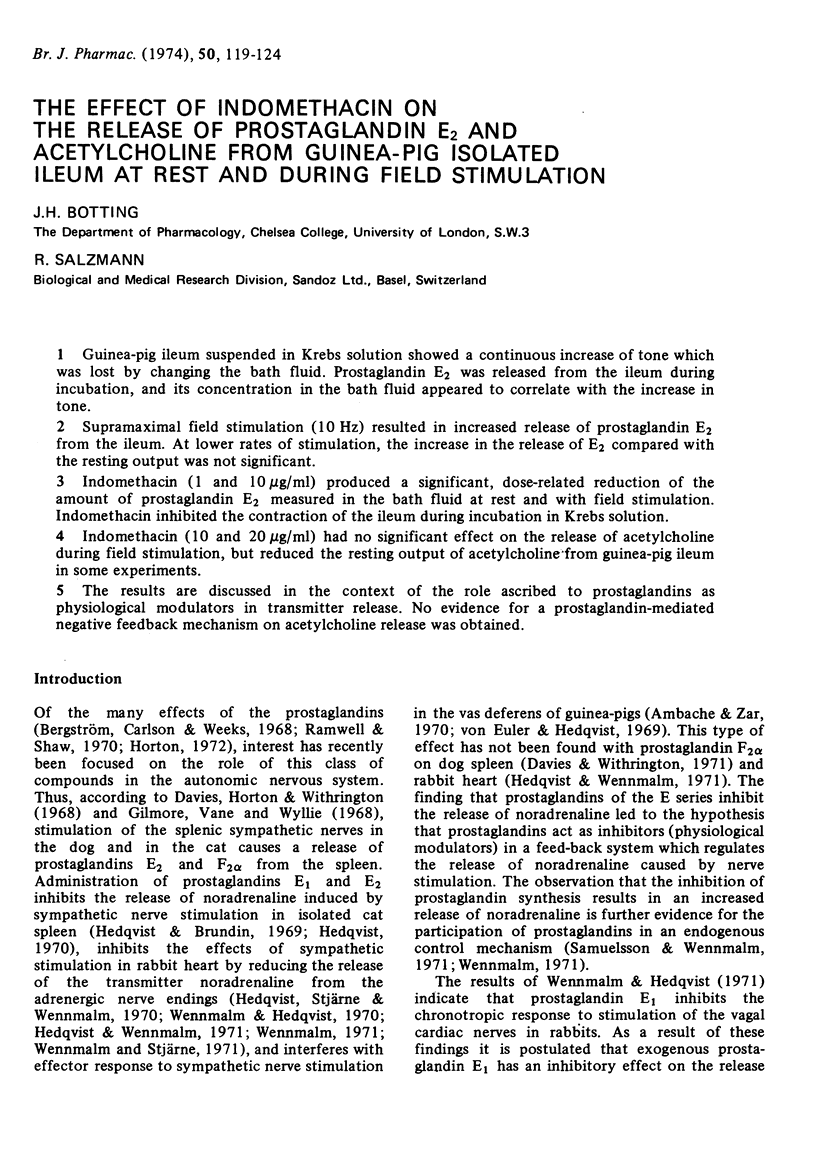
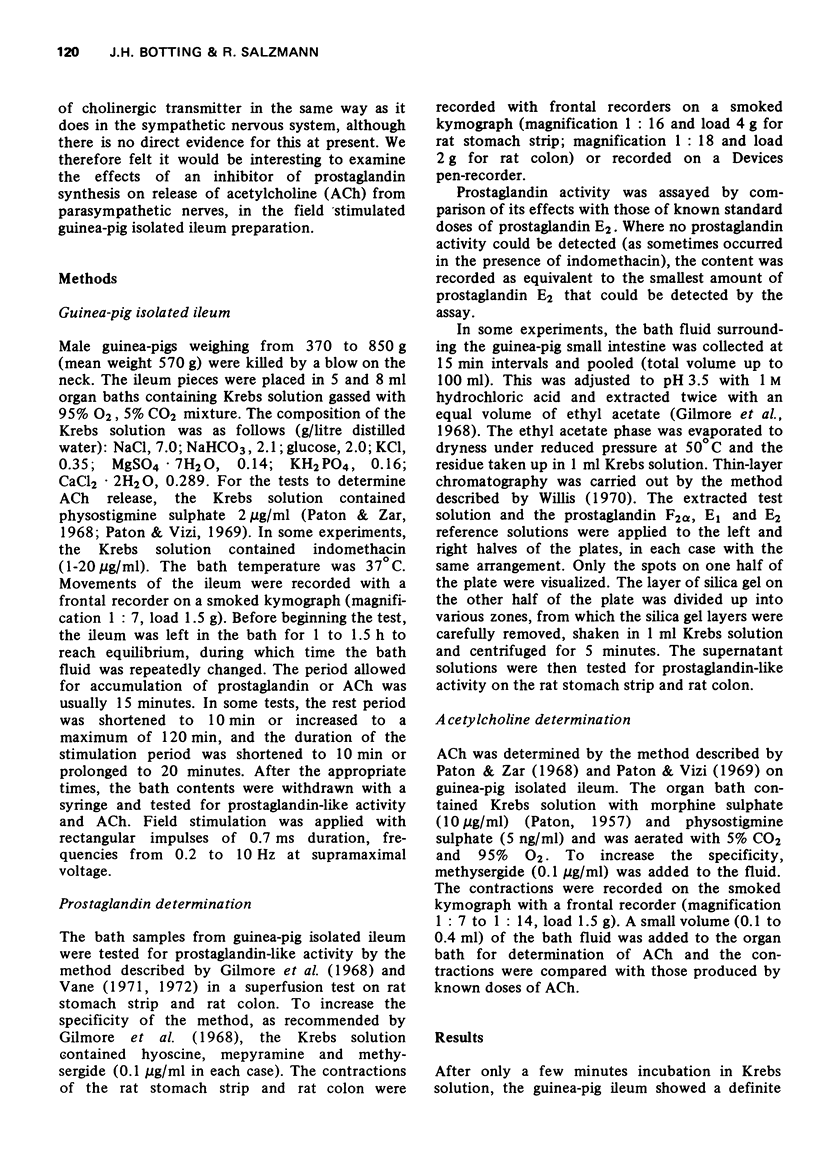
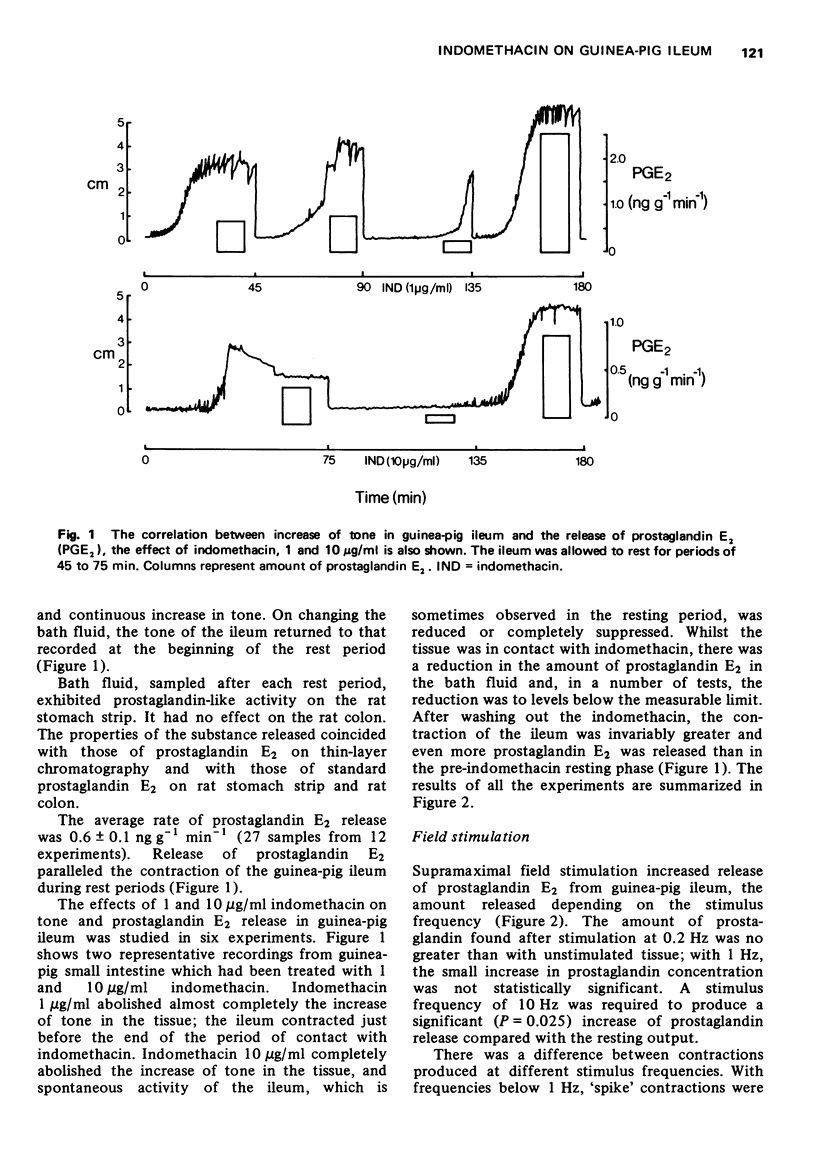
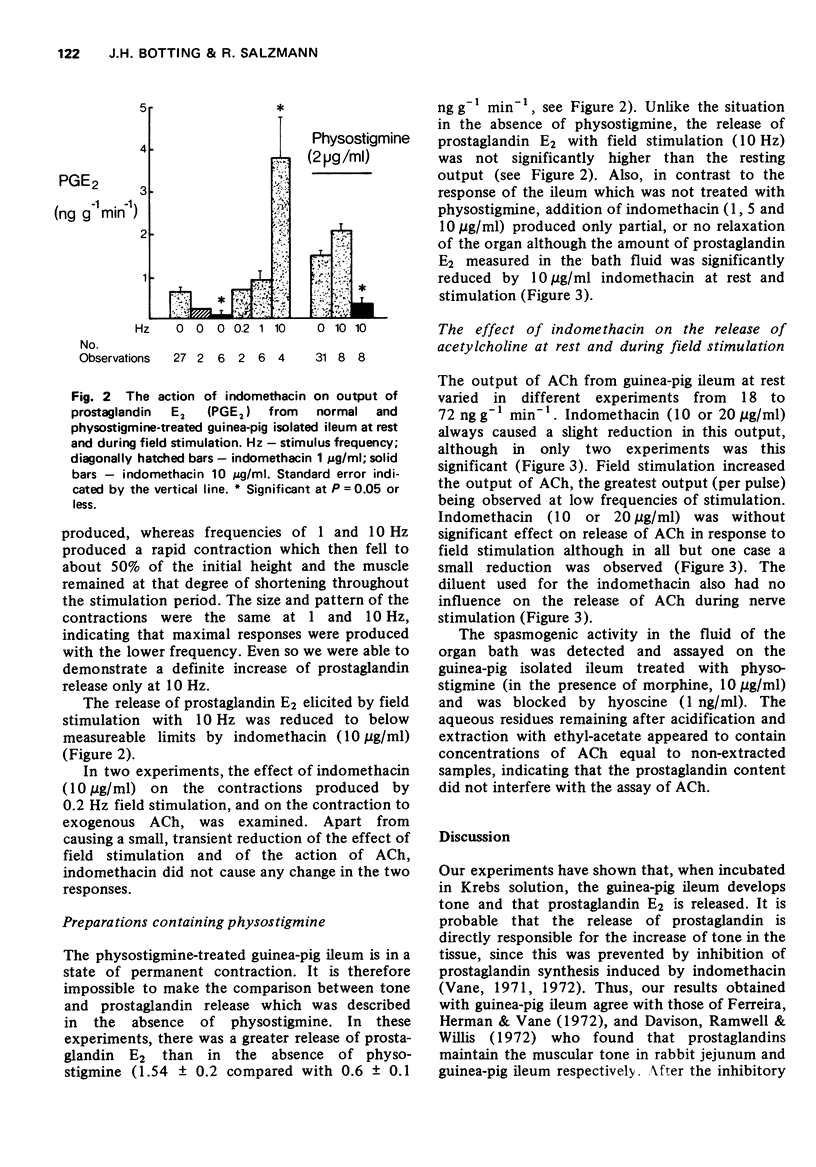
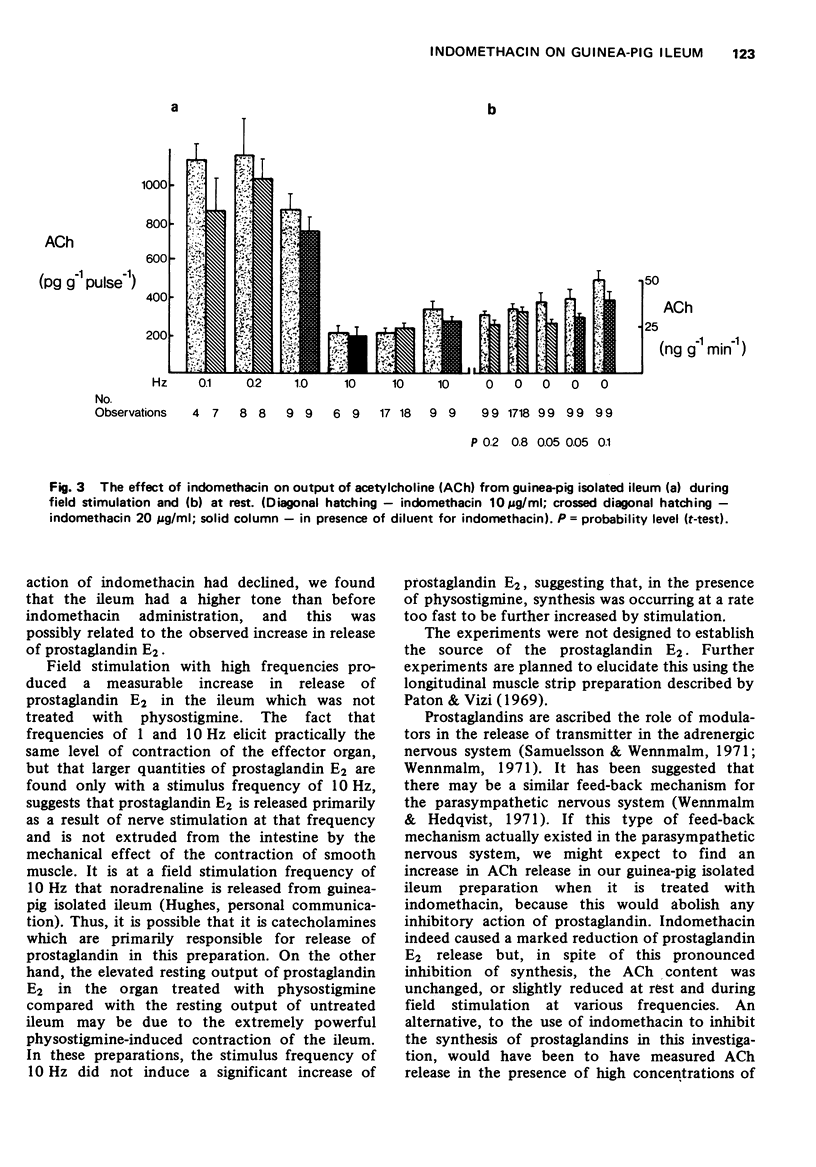
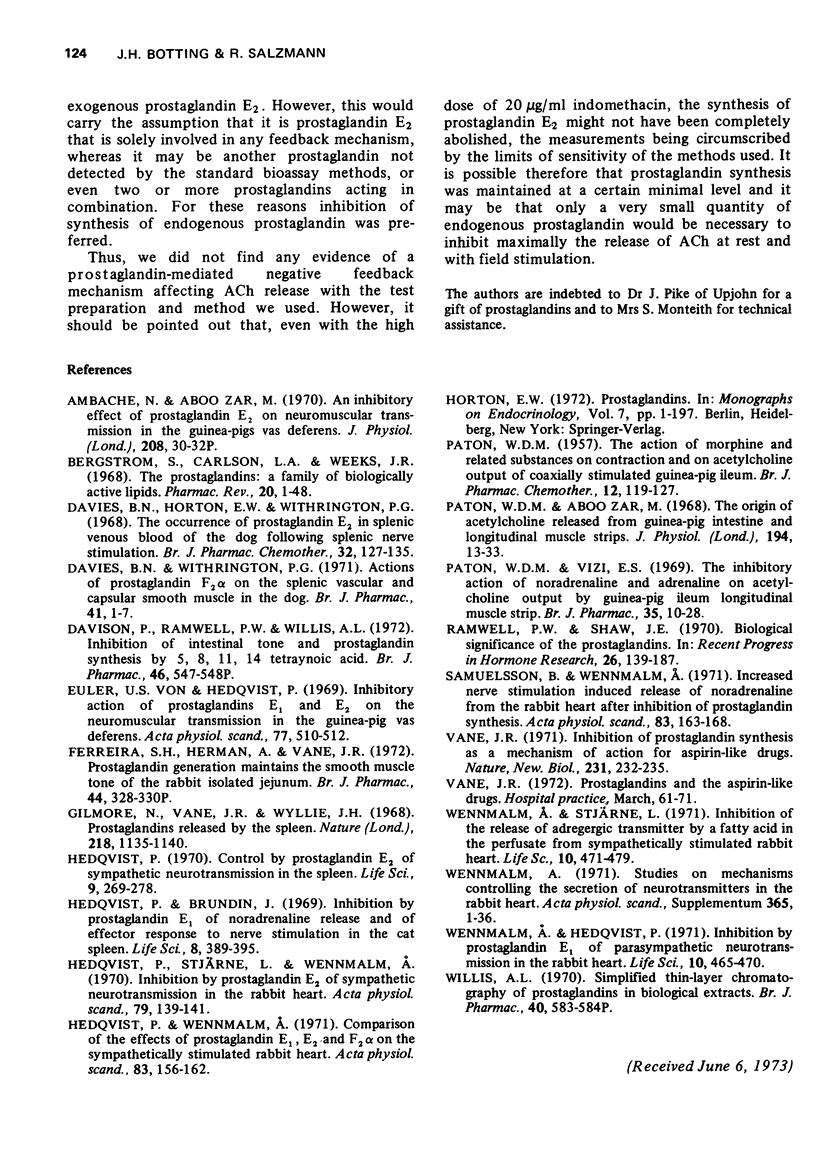
Selected References
These references are in PubMed. This may not be the complete list of references from this article.
- Davies B. N., Horton E. W., Withrington P. G. The occurrence of prostaglandin E2 in splenic venous blood of the dog following splenic nerve stimulation. Br J Pharmacol Chemother. 1968 Jan;32(1):127–135. doi: 10.1111/j.1476-5381.1968.tb00436.x. [DOI] [PMC free article] [PubMed] [Google Scholar]
- Davies B. N., Withrington P. G. Actions of prostaglandin F2-alpha on the splenic vascular and capsular smooth muscle in the dog. Br J Pharmacol. 1971 Jan;41(1):1–7. doi: 10.1111/j.1476-5381.1971.tb09929.x. [DOI] [PMC free article] [PubMed] [Google Scholar]
- Davison P., Ramwell P. W., Willis A. L. Inhibition of intestinal tone and prostaglandin synthesis by 5,8,11,14 tetraynoic acid. Br J Pharmacol. 1972 Nov;46(3):547P–548P. [PMC free article] [PubMed] [Google Scholar]
- Gilmore N., Vane J. R., Wyllie J. H. Prostaglandins released by the spleen. Nature. 1968 Jun 22;218(5147):1135–1140. doi: 10.1038/2181135a0. [DOI] [PubMed] [Google Scholar]
- Hedqvist P., Brundin J. Inhibition by prostaglandin E1 of noradrenaline release and of effector response to nerve stimulation in the cat spleen. Life Sci. 1969 Apr 1;8(7):389–395. doi: 10.1016/0024-3205(69)90232-x. [DOI] [PubMed] [Google Scholar]
- Hedqvist P. Control by prostaglandin E2 of sympathetic neurotrans-mission in the spleen. Life Sci. 1970 Mar 1;9(5):269–278. doi: 10.1016/0024-3205(70)90028-7. [DOI] [PubMed] [Google Scholar]
- Hedqvist P., Stjärne L., Wennmalm A. Inhibition by prostaglandin E2 of sympathetic neurotransmission in the rabbit heart. Acta Physiol Scand. 1970 May;79(1):139–141. doi: 10.1111/j.1748-1716.1970.tb04712.x. [DOI] [PubMed] [Google Scholar]
- Hedqvist P., Wennmalm A. Comparison of the effects of prostaglandins E 1, E 2 and F 2 alpha on the sympathetically stimulated rabbit heart. Acta Physiol Scand. 1971 Oct;83(2):156–162. doi: 10.1111/j.1748-1716.1971.tb05064.x. [DOI] [PubMed] [Google Scholar]
- Horton E. W. Prostaglandins. Monogr Endocrinol. 1972;7:1–197. [PubMed] [Google Scholar]
- PATON W. D. The action of morphine and related substances on contraction and on acetylcholine output of coaxially stimulated guinea-pig ileum. Br J Pharmacol Chemother. 1957 Mar;12(1):119–127. doi: 10.1111/j.1476-5381.1957.tb01373.x. [DOI] [PMC free article] [PubMed] [Google Scholar]
- Paton W. D., Vizi E. S. The inhibitory action of noradrenaline and adrenaline on acetylcholine output by guinea-pig ileum longitudinal muscle strip. Br J Pharmacol. 1969 Jan;35(1):10–28. doi: 10.1111/j.1476-5381.1969.tb07964.x. [DOI] [PMC free article] [PubMed] [Google Scholar]
- Paton W. D., Zar M. A. The origin of acetylcholine released from guinea-pig intestine and longitudinal muscle strips. J Physiol. 1968 Jan;194(1):13–33. doi: 10.1113/jphysiol.1968.sp008392. [DOI] [PMC free article] [PubMed] [Google Scholar]
- Ramwell P. W., Shaw J. E. Biological significance of the prostaglandins. Recent Prog Horm Res. 1970;26:139–187. doi: 10.1016/b978-0-12-571126-5.50008-x. [DOI] [PubMed] [Google Scholar]
- Samuelsson B., Wennmalm A. Increased nerve stimulation induced release of noradrenaline from the rabbit heart after inhibition of prostaglandin synthesis. Acta Physiol Scand. 1971 Oct;83(2):163–168. doi: 10.1111/j.1748-1716.1971.tb05065.x. [DOI] [PubMed] [Google Scholar]
- Vane J. R. Inhibition of prostaglandin synthesis as a mechanism of action for aspirin-like drugs. Nat New Biol. 1971 Jun 23;231(25):232–235. doi: 10.1038/newbio231232a0. [DOI] [PubMed] [Google Scholar]
- Wennmalm A. Studies on mechanisms controlling the secretion of neurotransmitters in the rabbit heart. Acta Physiol Scand Suppl. 1971;365:1–36. [PubMed] [Google Scholar]
- Willis A. L. Simplified thin-layer chromatography of prostaglanding in biological extracts. Br J Pharmacol. 1970 Nov;40(3):583P–584P. [PMC free article] [PubMed] [Google Scholar]
- von Euler U. S., Hedqvist P. Inhibitory action of prostaglandins E1 and E2 on the neuromuscular transmission in the guinea pig vas deferens. Acta Physiol Scand. 1969 Dec;77(4):510–512. doi: 10.1111/j.1748-1716.1969.tb04593.x. [DOI] [PubMed] [Google Scholar]


